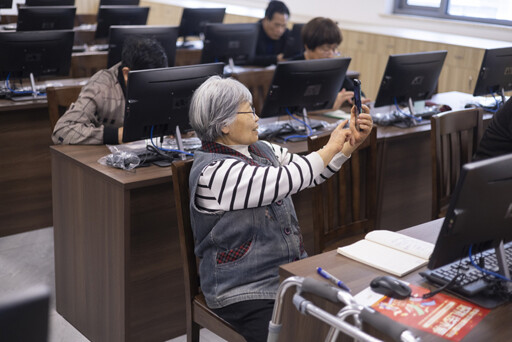


Technologies prompt innovation in aging society governance

Elderly people at a university for seniors, which features age-friendly designs, in Yongkang, Zhejiang Province. Photo: IC PHOTO
China is a vast, populous country with a rapidly aging population. Its enormous territory and marked regional disparities make the task of elderly care especially formidable and complex. Yet the country’s long history and rich cultural traditions—including deeply rooted family ethics, a social ethos of respecting elders and fulfilling filial responsibilities, and community values that emphasize harmony across generations and among neighbors—continue to provide a strong moral and social foundation for elderly care with distinct Chinese characteristics.
Technology’s impact on governance
Unlike the West, where population aging largely took place during the post-industrial era, China has entered this demographic phase in the midst of the information, digital, and intelligent age. This timing has opened up new avenues for innovation in governance, particularly in the realm of elderly care.
In recent years, research on the silver economy, digital economy, and smart elderly care has flourished alongside robust policy support. In February 2022, the State Council issued guidelines to promote national undertakings for the aged and improve the elderly care service system during the 14th Five-Year Plan period (2021–2025). In January 2024, the “Opinions on Developing the Silver Economy to Enhance the Wellbeing of the Elderly” was released. Both documents repeatedly emphasize the importance of “digitalization” and “intelligence” in enhancing elderly care services and improving the wellbeing of older adults.
According to the 55th Statistical Report on Internet Development in China, released on Jan. 17, 2025, the number of internet users aged 60 and over surged from 40,000 in 1999 to 160 million in 2024. The role of digital technology in enhancing the quality of life, promoting social participation, and supporting health management for seniors is growing rapidly. Notably, the more than two decades since China entered an aging society have coincided with some of the country’s most dramatic advances in digital development—positioning digital technologies as powerful tools for advancing elderly care with Chinese characteristics.
First, the rise of digital and intelligent technologies is reshaping the supply model for elderly care services. The integration of the Internet of Things, big data, cloud computing, and generative artificial intelligence is helping meet the diverse needs of seniors across home settings, communities, and institutional care. Digital platforms have optimized programs such as “Time Bank” and “Mutual Aid Elderly Care,” which merge traditional neighborhood-based mutual assistance with modern digital tools, improving the efficiency of resource sharing and peer-to-peer support.
In the realm of age-friendly infrastructure, both software and hardware are undergoing digital upgrades. Mobile apps and user interfaces have been adapted to better serve elderly users, while housing, public facilities, and roads are being retrofitted to meet the needs of aging populations. These developments are accelerating the transformation and upgrade of the elderly care industry.
Second, as digital and intelligent technologies continue to evolve, the accessibility, convenience, and precision of elderly care services are improving significantly. Telehealth and online consultation platforms are overcoming geographic barriers, giving rural seniors access to high-quality diagnostic and treatment resources via smart terminals. Wearable devices that combine multimodal biosensing with deep learning algorithms are creating closed-loop health management systems that support real-time monitoring, early risk alerts, and targeted intervention—shifting the model of healthcare from reactive treatment to proactive prevention.
In addition, dynamic demand analysis systems powered by large models are making it possible to move beyond standardized service provision. By learning from individuals’ behavioral patterns and personal preferences, these tools can help generate customized services in key areas such as cognitive support and emotional care.
Algorithmic governance essential
As digital technologies continue to permeate everyday life, a new social structure is emerging—one in which “everything is connected.” This transformation has enormous potential to improve living conditions and wellbeing for older adults, signaling the start of a new chapter in China’s innovative approach to elderly care.
At the same time, the widespread application of digital technologies is contributing to a new kind of digital divide. Despite progress in expanding access, older adults still face barriers in usage and digital literacy. Infrastructure improvements, better-designed technologies, and digital literacy programs have helped to narrow these gaps—but challenges remain.
More critically, the increasing sophistication of algorithms, big data systems, and large models—often driven by “performance logic,” “instrumental rationality,” or even “capital rationality”—can put older users at a disadvantage. Algorithmic “irresponsibility” can expose seniors to risks such as digital manipulation, privacy breaches, online harassment, and communication breakdowns. In some cases, ethical concerns—such as age-based algorithmic bias or opaque “black box” systems—may deepen inequality or heighten insecurity.
The challenges and opportunities presented by the digital era highlight the need to change our mindset. It is crucial to leverage smart elderly care services to unleash the dividends of digital technologies and ensure that technological achievements benefit different age groups. More importantly, such efforts must go beyond expanding access; they must also focus on algorithmic governance—supervising and regulating the technologies used by and for the elderly to ensure alignment with social values and ethical norms. This requires fostering a culture of digital inclusion, building accessible infrastructure, and helping older adults better adapt to digital life through stronger support from families and communities.
In addition, we should build a people-oriented framework for algorithmic governance, encompassing technical specification, legal regulation, and value reconstruction. Upholding the principle of “algorithms for good,” improving seniors’ digital literacy, and building an inclusive, safe, and effective intelligent elderly care system will be critical. In so doing, technology can become a pivotal force in advancing Chinese modernization and proactively responding to population aging, thereby better serving the well-rounded development of the elderly.
Hu Zhan is a professor from the Fudan Institute of Ageing. Yin Siwei is from the School of Social Development and Public Policy at Fudan University.
Editor:Yu Hui
Copyright©2023 CSSN All Rights Reserved